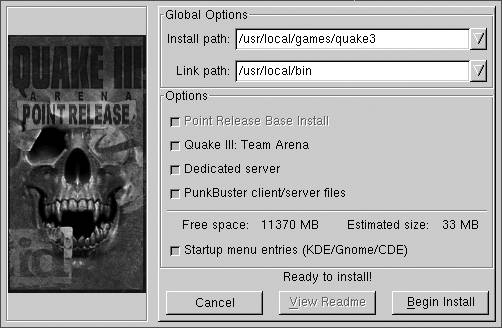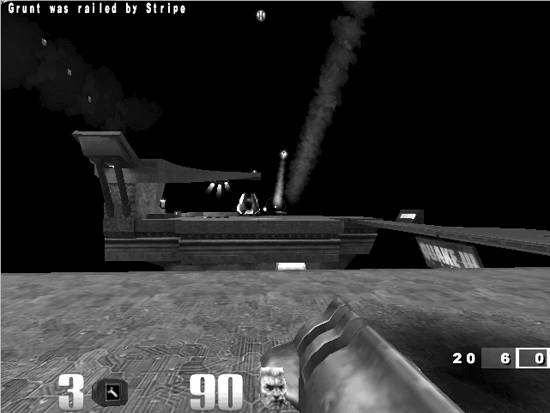Section 7.2. Quake III
7.2. Quake IIIThe Quake series has long been a favorite among FPS fans for its addictive yet simple gameplay and its graphics, which have always pushed the envelope for the time. Although Quake and Quake 2 were initially single-player games, both became very popular for multiplayer deathmatch games over a network. With Quake III, Id Software took the Quake universe and created a game strictly aimed at multiplayer gaming. In Quake III there is a single-player mode, but it revolves around playing a series of deathmatch games against one or more computer opponents in an arena style. As you progress in the game the opponents get more difficult to defeat; in the final round, you are one-on-one with an incredibly accurate opponent. In many ways the single-player mode is practice for multiplayer games on the network. The entire Quake series has Linux binaries available for download from ftp.idsoftware.com. When Quake III was first released, Linux binaries weren't available; however, a special tin box edition of the game containing Linux binaries was released in stores some time after the initial Windows version. Even if you didn't get the special tin box edition, you can still use your Windows CD and download the Linux installer. 7.2.1. InstallationTo install Quake III under Linux, download the latest version of the installer from the ftp.idsoftware.com/idstuff/quake3/linux directory. Once you have downloaded the file, use chmod +x filename to make it executable and then run the installer from a console as root. Accept the licensing agreement to then see the main installer window (Figure 7-1). The installer will default to putting the game files into /usr/local/games/quake3. The installer from the Linux retail CD will copy the .pk3 data files from the CD-ROM, but the installer that you download will not. Therefore, if you used the downloaded installer, mount the Linux or Windows Quake III CD and copy pak0.pk3 from the Quake3/baseq3 directory on the CD to /usr/local/games/quake3/baseq3. If you also have the Team Arena CD-ROM, you can mount that CD and copy pak0.pk3 from the Setup/missionpack directory to /usr/local/games/quake3/missionpack/. Figure 7-1. Quake III Installer Once Quake III is installed, click the corresponding icon in your KDE or GNOME menu, or type quake3 in a console. Quake III relies on OpenGL as its graphics library, so make sure that you have 3D hardware acceleration with OpenGL support. Unlike with the Windows version, the Linux version of Quake III does not require you to have the CD-ROM in the drive to start the game. Once the game begins for the first time, a .q3a directory is created in your home directory to store settings and saved games. You can edit the configuration files directly if you wish, or you can change game options through the Setup menu on the main screen. 7.2.2. Single PlayerIn single-player mode you can either start with the first arena match and move map by map through the game, or you can immediately get to the action and click the skirmish button inside the single-player screen. A skirmish is a quick match that doesn't count toward the standard single-player game. You can choose any map and also how many and which bots to play against on the map, along with their difficulty. Skirmish mode is very useful to hone your skills on a particular map, especially before you move to a multiplayer game. The rules for a standard deathmatch are pretty simplekill everyone else. When a match starts, your player is spawned in one of the many spawn points on the map. Once the match starts the object is to have the most frags, or kills, before the time limit lapses. Scattered across the map are weapons; items such as health, ammo, and armor, and your opponents. You start off with a simple machine gun and your gauntlet, so you will want to find more powerful weapons, especially before your opponents do (Figure 7-2). Your player starts out with 100 hit points, which decrease as you take on damage. If you reach zero or fall into one of the bottomless pits on the map, your character dies and you "respawn" at a random spawn point on the map. Any opponents you kill also respawn in this way. There are no limits to the number of times you can respawn, but keep in mind that you lose any weapons and armor you previously had, so try to keep respawning to a minimum. The Quake series is known for supplying a basic set of weapons to choose from, and Quake III continues in that tradition by including many favorite weapons from previous games without having too much overlap in weapon functions. It is worthwhile to get familiar with all of the different weapons because each can be useful in different types of combat.
Along with weapons, there are a few other items you will find in the maps, some of which give you extra abilities. There are the normal health and ammo packs that regenerate across the map, and on some maps there is a Quad Damage item. If a player picks up this item, the announcer says "Quad Damage" and the player shines a bright blue that makes him easy to see from a distance. If you pick up Quad Damage, all of your weapons inflict four times their damage for a limited time, useful for racking up quick kills. Be careful, though: if you are killed with time remaining, the Quad Damage will be left behind, so other players have an incentive to kill you. 7.2.3. MultiplayerQuake III was primarily designed to be played in multiplayer mode . The multiplayer mode is not much different from single-player mode except that you are fighting other people instead of computer-controlled bots. When you click the Multiplayer option from the main menu, you are taken to the Quake III server browser. Here you can see a list of available game servers you can connect to, along with the map and game type currently in progress and the number of players on the server. You can also specify a particular server to connect to by IP address. If you want to create your own server, click Create and select a map and number of bots for your own server and click Fight to launch the server. If you change the Dedicated option before you launch the server, the server will launch in the background. Otherwise, the server will start and you will immediately be connected to it. If you want to create your own customized dedicated server, particularly one that runs without the client from the command line, check out some of the great Quake III server HOWTOs on the Internet. A good place to start is http://www.planetquake.com/quake3/q3aguide/server-setup_a.shtml. There are a number of multiplayer game types, and many of them require special mods or maps to be installed on your system. The basic game types are baseq3, which is the standard multiplayer deathmatch, and CTF, which is a standard two-team capture-the-flag match. Once you find a game you wish to join, click on the server and then click the Fight button at the bottom of the screen to connect. 7.2.4. ModsLike the previous versions of Quake, Quake III has a large number of community-created mods for it. Some of these mods are simplistic and add a new weapon or new basic game type, whereas other mods are very extensive and change maps, weapons, and even the major rules of the game. To find mods, skins, and maps to add to your Quake III install, visit www.planetquake.com. Among the many mods and files hosted on that site is a popular mod called Rocket Arena 3 (RA3 ) at http://www.planetquake.com/servers/arena/. Rocket Arena 3 is the continuation of the Rocket Arena mods that were available for Quake and Quake II; it takes deathmatch play and changes a few of the rules to result in a unique style of game play. First, by default in Rocket Arena 3, you start with all of the weapons fully loaded. This means no longer running around a map trying to find the more powerful weapons you can get right to fragging. Second, your player is not hurt by his own splash damage. This means you can do manuevers like rocket jumps (firing a rocket below you as you jump, launching you high into the air) without any damage. These two changes in the rules, combined with a completely new set of maps result in a very different deathmatch game. On RA3 servers, you can select to play directly against another player one-one-one or in a team deathmatch. Unlike in standard deathmatch, you only have one life, so when you die you must wait until the current match ends before you can get back in the game. Installing RA3 takes only a few steps. First go to the RA3 site and find the Linux/Mac installer on the downloads page, a 135Mb .zip file. Then unzip the file into /usr/local/games/quake3/ where it should create an arena directory. To play RA3 start Quake III from the command line with quake3 +set fs_game arena or select "arena" from the Mods menu in Quake III. If you want to host your own RA3 server, a sample server script has already been created for you called ra3server in the arena directory. Launch it to start a dedicated RA3 server. Read the readsrv.txt file in the arena directory for more information on how to customize the RA3 server. |
EAN: 2147483647
Pages: 220
